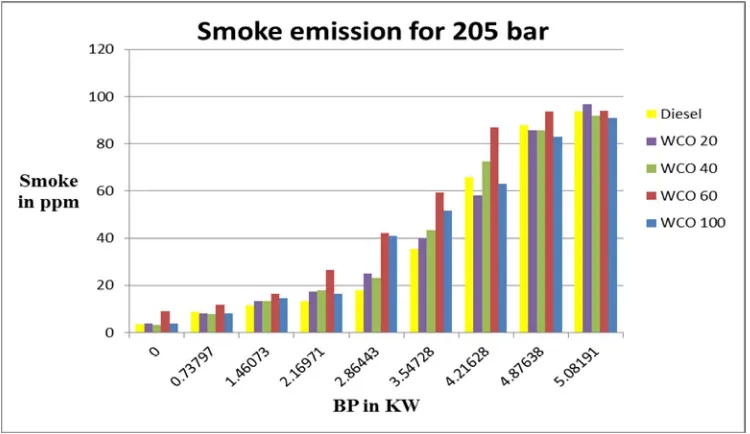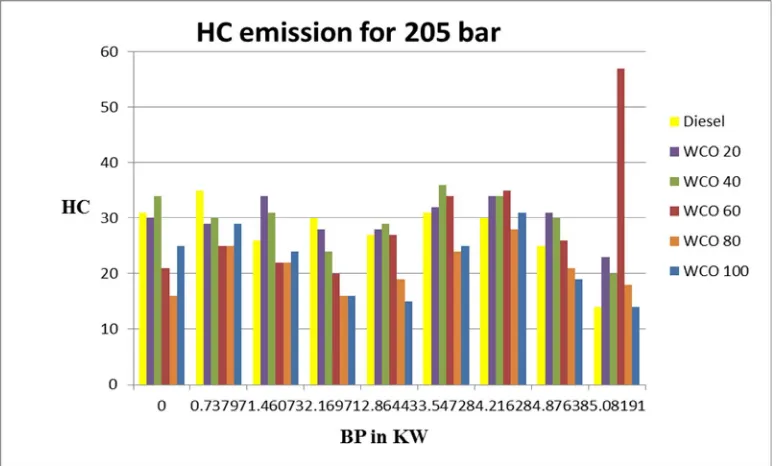ISSN(Online): 2319-8753 ISSN (Print): 2347-6710
International Journal of Innovative Research in Science,
Engineering and Technology
(An ISO 3297: 2007 Certified Organization)
Website: www.ijirset.com
Vol. 6, Issue 8, August 2017
Emission Characteristics of CI DI Engine
Using Blends of Biodiesel (Waste Cooking Oil)
and Diesel Fuel
Rajesh Gurani1, Prashant B Tadalagi2, Malikasab Bagawan3
Research Scholar, Department of Mechanical Engineering, Basaveshwar Engineering College, Bagalkot,
Karnataka, India1,2
Assistant Professor, Department of Automobile Engineering, M V S R Engineering College,
Nadergul, Hyderabad, India 3
ABSTRACT: In the present era the whole world is concerned about the effect of environment pollution and the emissions from automobile because of use of fossil fuel is considered as a major contribution to it. The second aspect of the fossil fuel is the depletion of fuel leads to thinking of alternative fuel for running the automobiles. Biodiesel is proved to be the best replacement for diesel because of its unique properties like significant reduction in green house gas emissions, non-sulfur emissions, non-particulate matter pollutants, low toxicity and biodegradability. This paper is mainly concentrated on the biofuel (produced from Waste Cooking oil) blends and their effect on the emissions of automobiles. After conducting several experiments it is concluded that the emission level for HC and CO are less for biodiesel and its blends and for NOx and Smoke density is higher for biodiesel and its blends when compared with pure diesel.
KEYWORDS: WCO Biodiesel, HC, CO, NOx and Smoke emission levels
I. INTRODUCTION
Motor vehicles play a conspicuous role in the modern industrial economy—and in shaping our natural and built environment. Cars and light trucks offer rapid, reliable, and convenient mobility on demand to an ever-growing number of people in countries throughout the world. But for all their positives, automobiles carry with them many negatives. Vehicles are a major contributor to air pollution around the world.
Vehicles account for most of the carbon monoxide (CO), and a large share of the hydrocarbons (HC), nitrogen oxides (NOx), and particulates in major urban areas. Diesel engines have higher emissions of NOx and they have significant emissions of fine particulates. Recent evidence shows that fine particulates may be the most serious threat to human health in urban areas. Vehicle emissions are responsible for up to 50 percent of the emissions that form ground-level ozone and up to 90 percent of carbon monoxide in major metropolitan areas. They also contribute to global warming, accounting for a large and growing share of greenhouse gas emissions worldwide.
ISSN(Online): 2319-8753 ISSN (Print): 2347-6710
International Journal of Innovative Research in Science,
Engineering and Technology
(An ISO 3297: 2007 Certified Organization)
Website: www.ijirset.com
Vol. 6, Issue 8, August 2017
II. OBJECTIVES
The main objectives of this are:
Investigating the properties of the biodiesel as well as blends of biodiesel with diesel.
Experimental investigation of the performance on single cylinder four stroke diesel engine using waste cooking oil
methyl ester biodiesel and its blends.
Smoke and various emissions are measured using smoke meter and gas analyzer.
III. EXPERIMENTAL SET UP
The experiments are carried out on single cylinder, 4-stroke Kirloskar diesel engine. The schematic experimental setup is shown in fig. 1. Engine is interfaced with computer for measuring the different parameters. Engine soft software is used in computer to carry out the measurements. The engine is coupled with an eddy current dynamometer used to measure the emissions and smoke density.
Table 1: Engine Specifications
Make Kirloskar Engine
Bore & stroke 87.5mm x110mm
Type of cooling Water cooled
Speed 1500 rpm
Compression ratio 17.5:1
Number of cylinder 1
Rated power 5.2 kW
Start of injection 23˚ bTDC
ISSN(Online): 2319-8753 ISSN (Print): 2347-6710
International Journal of Innovative Research in Science,
Engineering and Technology
(An ISO 3297: 2007 Certified Organization)
Website: www.ijirset.com
Vol. 6, Issue 8, August 2017
IV. RESULTS AND DISCUSSION
The performance of CI DI engine using the biodiesel namely WCOME biodiesel with diesel blends and pure diesel are studied at different loads and at different injection pressure. The performance and emissions of different blends and for neat diesel are carried out at different loads and compared the results of various blends of biodiesel and diesel with neat diesel fuel.
a) Effect of Bio-diesel on smoke emission:
The smoke emission level for different BP for each blend is obtained from data and were plotted as shown in figure 2. The graph indicates that smoke level for WCO biodiesel and its blends has increased with less percentage compared with that of the pure diesel engine up to a load of 4.2KW or 15kg and beyond this 4.2KW load there is a sign of decrease in smoke emissions for WCO biodiesel and its blends. At the time of injection a smaller atoms of biodiesel fuel having lesser inertia takes longer time for combustion or incomplete combustion at lower loads (below 4.2KW). This results in increase smoke level for WCO biodiesel and its blends.
Fig 2: Emissions of Smoke Density for 205 bar
b) Effect of Bio-diesel on CO emission:
ISSN(Online): 2319-8753 ISSN (Print): 2347-6710
International Journal of Innovative Research in Science,
Engineering and Technology
(An ISO 3297: 2007 Certified Organization)
Website: www.ijirset.com
Vol. 6, Issue 8, August 2017
Fig 3: Emissions of CO for 205 bar
c) Effect of Bio-diesel on HC emission:
ISSN(Online): 2319-8753 ISSN (Print): 2347-6710
International Journal of Innovative Research in Science,
Engineering and Technology
(An ISO 3297: 2007 Certified Organization)
Website: www.ijirset.com
Vol. 6, Issue 8, August 2017
d) Effect of Bio-diesel on NOx emission:
The smoke emission level for different BP for each blend is obtained from data and were plotted as shown in figure 5. By anaysing the graph it is clears that at lower loads (less than 4.2KW) NOx emissions for biodiesel and its blends are higher when compared with the pure diesel. In molecular structure of biodiesel the presence of oxygen is used in combustion of fuel. At lower level due to incomplete combustion these oxygen molecules are not converted from CO to CO2. This CO will react with Nitrogen and frms NOx at lower loads and hence there will be increase in NOx emissions at lower loads.
Fig 5: Emissions of NOx for 205 bar
V. CONCLUSIONS
From the present investigation it is concluded that the emission levels of HC, CO, NOx and smoke density have different limits at lower loads and at higher loads, the results are adverse with each other. From this investigation the emission level for HC and CO are less for biodiesel and its blends and for NOx and Smoke density is higher for biodiesel and its blends when compared with pure diesel. This investigation is also suggests that the controlling of emissions for HC, CO, NOx and smoke density is effective for lower blends of biodiesel with that of diesel.
REFERENCES
[1] Jagannath Hirkude, Atul Padalkar, Deepa vedartham, “An Investigations on the effect of waste fried oil methyl ester blends and loads on performance and smoke opacity of diesel engine using response surface methodology”. Energy Procedia 54 ( 2014 ) 606 – 614 2013.
[2] Wail M. Adaileh, and Khaled S. AlQdah (2014) has investigated “The Performance of Diesel Engine Fuelled by a Biodiesel Extracted from a Waste Cocking Oil”
[3] Shivaji Bhandarkar, “Vehicular Pollution, Their Effect on Human Heatlh and Mitigation Measures”. Vehicle Engineering(VE) Volume 1 Issue 2, June 2013.



